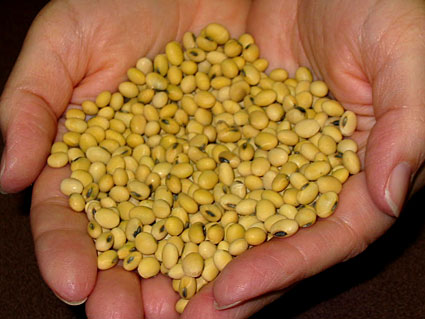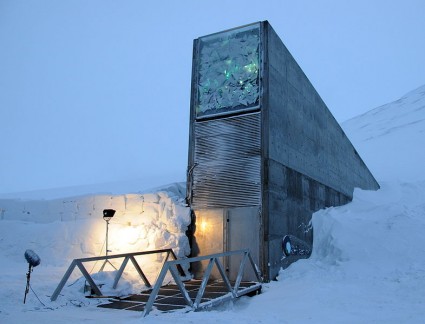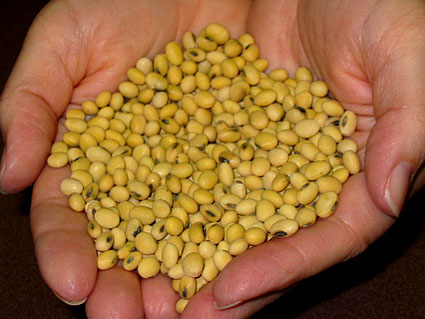 Monsanto’s Roundup Ready soybean seedPhoto: MonsantoThe first in a series of daylong federally sponsored workshops kicked off today in Ankeny, Iowa, to debate whether consolidation in agriculture — in particular in the seed industry — has stifled competition and harmed farmers.
Monsanto’s Roundup Ready soybean seedPhoto: MonsantoThe first in a series of daylong federally sponsored workshops kicked off today in Ankeny, Iowa, to debate whether consolidation in agriculture — in particular in the seed industry — has stifled competition and harmed farmers.
While it may be much more convenient for farmers to do their one-stop seed shopping at Monsanto, DuPont, and Syngenta, et al — assuming they don’t mind that the selection is starting to resemble Soviet-era grocery stores — it certainly hasn’t saved them money.
In the past year, farmers have paid 32 percent more for corn seed and 24 percent for soybeans, reports the New York Times. USDA figures show that corn seed prices have risen a hefty 135 percent and soybeans 108 percent since 2001, five times the Consumer Price Index. Monsanto alone is responsible for the patented technology used in more than 90 percent of corn and 80 percent of soy grown in this country. The rising prices and the shrinking number of companies selling seeds have caught the attention of the Justice Department, which began an antitrust investigation of the industry last year, focusing on Monsanto. (Grist has been documenting the company’s shenanigans for years.)
Seeds of acrimony
At issue is whether the St. Louis-based company is using its power to keep competing technologies off the market and leave farmers no choice but to pay whatever it wants to charge. Monsanto says the rising prices are justified because the seeds now come with more bells and whistles, and the company’s lawyers argue that because Monsanto licenses its RoundupReady gene to other corporations, like DuPont, to combine into their own “stacked” seeds, its practices are not anticompetitive. Critics say the licensing agreements are overly restrictive and often worded in such a way as to compel the licensee to sell Monsanto’s traits over those of competitors.
It’s possible that the company’s patents may trump antitrust law, suggests a Bloomberg article today, citing previous cases with Xerox in which the courts sided with the intellectual property holders. And indeed, there are many parallels with previous antitrust cases against AT&T (before the company’s 1984 breakup) and Microsoft (for its Windows dominance in the 1990s) — and many of the same faces. DuPont has hired the lawyer who led the government’s case against AT&T, while Monsanto’s enlisted Dan Webb, who defended Microsoft in 2002 against the feds. (Over at the Beyond Green blog, Grist contrubutor Tom Laskaway worries that the biotech-friendly Obama administration’s goal in these antitrust investigations appears to be to broaden access to Monsanto’s intellectual property rather than improve access to conventional seeds.)
Today’s hearing in Iowa is subtitled “Issues of Concern to Farmers,” but sustainable agriculture groups have complained that the panels are heavily tilted toward politicians and academics and allow little time for public comment. Even former American Farm Bureau President Dean Kleckner told the Des Moines Register that the session today “will be mostly for show. It’s about politics and posturing.”.
To protest, groups like Iowa Citizens for Community Improvement and Food Democracy Now are holding their own parallel workshops and events. Last night more than 250 small farmers and activists packed a town hall meeting and chanted “Bust up Big Ag.” And today, “Lunch from a Farmer’s Perspective” — sponsored by Farm Aid, the National Family Farm Coalition, the Farmer to Farmer Campaign on Genetic Engineering, and others — brings together farmers who’ve been directly affected by seed market concentration. Among them is Moe Parr, the seed cleaner who Monsanto essentially put out of business through extended legal harassment over whether he was helping farmers to “brown bag,” or illegally save and replant, Monsanto’s seeds.
 Entrance to the Svalbard “Doomsday” Seed Vault in Norway/Vaulting ahead
Entrance to the Svalbard “Doomsday” Seed Vault in Norway/Vaulting ahead
In other seed-related news this week, the super-cool-looking two-year-old Svalbard “Doomsday” Global Seed Vault in Norway just received thousands of new seeds that puts its collection over the half-million mark. Among the new samples are 400 from the Seed Savers Exchange, an Iowa-based nonprofit, including the German Pink tomato, a rare large, hardy sweet-flavored tomato variety transported to Iowa in 1883 by a Bavarian immigrant who is the grandfather of one of the co-founders of the Seed Savers Exchange.
The half-million milestone “brings mixed emotions, because while it shows that the vault at Svalbard is now the gold standard for diversity, it comes at a time when our agriculture systems are really sitting on a knife’s edge,” said Cary Fowler, executive director of the Global Crop Diversity Trust, in the press release. (The trust partners with the Norwegian government and the Nordic Genetic Resource Center in Sweden for the vault.) “If crops and agriculture don’t adapt to climate change, neither will humanity. But to help farmers adapt, plant breeders need access to as much genetic diversity as possible to keep crops vigorous and productive in shifting climates.”
Somewhat ironically, given the hearings in Iowa, the USDA’s National Center for Genetic Resources Preservation sent the vault a soybean collection that comprises almost the entire lineage of soybeans developed in the U.S. in the last century, as well as hundreds of wild soybeans. The seeds include disease-resistant varieties and soybeans with genetic traits that could be especially important for dealing with the stresses of climate change.
Banks that really need a bailout
But university researchers will no more have access to these particular seeds than they will to Monsanto’s patent-locked varieties. The vault’s seeds are duplicates of those maintained by national and regional crop genebanks, intended for safekeeping, not for everyday use. And as Fowler notes, many of these collections are threatened by neglect and lack of funds.
The USDA’s National Center for Genetic Resources Preservation and the National Plant Germplasm System, for example, through which researchers can request seeds to study and breed, are part of the USDA’s Agricultural Research Service arm. The total ARS budget for 2009 was $1 billion, down 17 percent from 2008 (PDF from USDA).
Compare this with Monsanto’s 2009 gross profit of $4.5 billion for its seeds and genomics unit [PDF of annual report]. The market dominance of Monsanto and others is not the only threat to preserving seed diversity in this country — budget cuts to federal and dwindling funds for independent research at public universities are equally concerning. Because if we really are worried about “feeding the world” in a changing-climate future, it might be a good idea to hedge our bets a tad, not put all our faith in one patent-locked-up seed supply.


